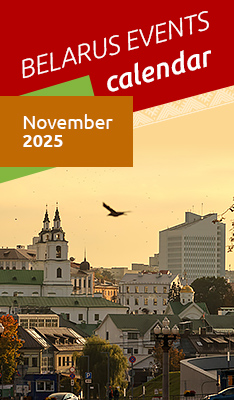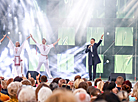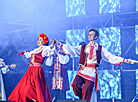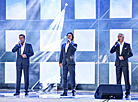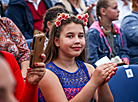Belarusian Written Language Day celebrations in Belynichi
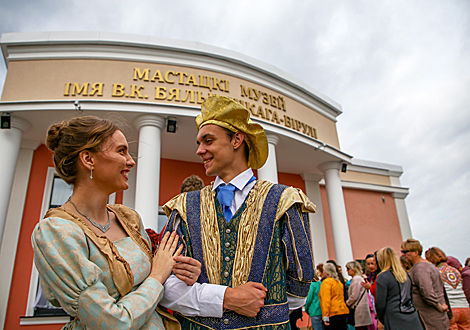
In 2020, the Belarusian Written Language Day was marked in Belynichi, Mogilev Oblast.
Belynichi is a town of rich history and unusual sacral fate. According to one legend, the town’s foundation and name are related to the wonder-working icon of the Mother of God of Belynichi. It is believed that in the early 13th century the icon was brought by the Kiev Pechersk Lavra monks who were running from Khan Batyi’s forces. One night during a rest break near the Druts River the icon started glowing. The decision was made to set up a monastery there. The town got the name Belynichi, which means “belyye nochi” (white nights). Centuries ago this relic was honored in the whole Grand Duchy of Lithuania, and worshiped by Orthodox, Catholics and Uniates. Today the image of the Mother of God of Belynichi decorates the town’s coat of arms. The icon itself, one of the most venerated icons of Belarus, vanished together with the Cross of Euphrosyne of Polotsk in the mid-1920s. People still believe that the icon guards their land. Pilgrimages are annually held across the places related to the icon.
One of the highlights of the Belarusian Written Language Day was the inauguration of a new sculpture – the Appearance of the Icon – near the church in honor of the Belynichi Icon of the Mother of God. A granite angel, 3x2m in size, holds a bronze sanctity, as if embracing it with wings decorated with a pattern commonly used in the Belarusian vytinanka paper-cutting. Mogilev artisan Aleksandr Minkov noted that he was very excited to work on this project, because many years ago he himself was baptized in the local church.
Ancient Belarusians believed in the miraculous power of boulders, standing stones and water. Necropolises dating back to the 16th-18th centuries with stone crosses and boulders have preserved in several villages across Belynichi District. The most interesting of them is located not far from the village of Zaozerye: these boulders bear patterns looking like human footprints. According to one of legends, they belonged to Christ and the Mother of God. People believed that their land was chosen by God and was under the protection of the Mother of God.
Another legend says that the settlement on the Druts River was founded by Slav Belyn or his sons and descendants. And yet, the earliest chronicle mention of Belynichi dates back to the 16th century, when the famous hetman of the Grand Duchy of Lithuania Leu Sapieha became the owner of this territory.
In the mid-17th century, a Carmelite monastery with a grandiose stone church was founded in Belynichi. For decades, it was the largest religious center in the east of the Grand Duchy of Lithuania. In Soviet times, the church was blown up, and the monastery became home to secular facilities. Unique old frescos depicting scenes from the Bible disappeared under layers of paint. After a huge fire, the authorities decided to demolish the building completely, but restoration artists were lucky to salvage the remaining frescos. For years, they were kept in museums of Mogilev.
This priceless heritage was returned to Belynichi in 2020. A new building of the museum featuring the hall “Spirituality” opened on the Belarusian Written Language Day. The fresco Bearing the Cross, or The Procession to Calvary, became the centerpiece of the exhibition. It was recovered from the ruins of the monastery by Yuri Malinovsky and his colleagues in the late 1970s. Yuri Malinovsky then proceeded to conserve and restore the item and finally put it on display in the museum.
Once new premises became available, the concept of the Belynichi museum changed a bit but the gallery of Vitold Byalynitsky-Birulya – a famous landscape painter, whose works made places in Belarus known all over the world – remained the centerpiece. The gallery demonstrates his pictures and personal belongings, gives a glimpse into various episodes of his life. Apart from that, a large chamber was opened for travelling exhibitions. A school for young painters will operate under the aegis of the museum. The museum will also host scientific conferences and seminars.
Another chamber in the museum is dedicated to the history of the Belynichi land from times immemorial up till now.
The rich legacy of Belynichi, the legacy of prominent figures of the past was in the center of attention on the Belarusian Written Language Day. Apart from that, the 90th anniversary since the birthday of Vladimir Korotkevich, one of the most prominent writers of Belarus, was high on the agenda of this year’s celebration of the national culture and the written word.
An extensive program for Belarusian Written Language Day guests was prepared in Belynichi. A concert stage was deployed in front of the building of the new museum. Key themed sites of the celebration were located in Sovetskaya Street and in the ancient park Lime Grove, which had been spruced up in anticipation of the celebration. The new alley of cities that have hosted the Belarusian Written Language Day was solemnly opened on the festive day: over 20 maple trees were planted by the festival’s guests of honor.
A symbolic ceremony to pass over the relay race baton to the next capital of the Belarusian Written Language Day took place. The city of Kopyl in Minsk Oblast will host the festival in 2021.


